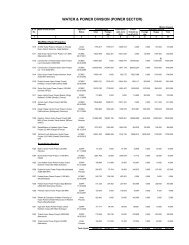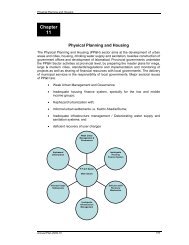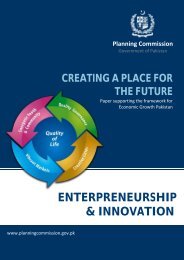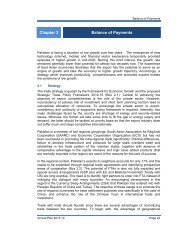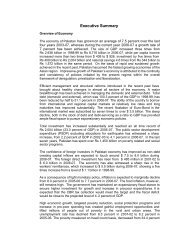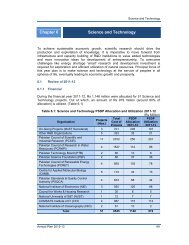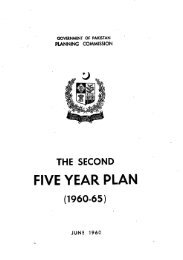Framework for Economic Growth, Pakistan - Planning Commission
Framework for Economic Growth, Pakistan - Planning Commission
Framework for Economic Growth, Pakistan - Planning Commission
Create successful ePaper yourself
Turn your PDF publications into a flip-book with our unique Google optimized e-Paper software.
International conference on “<strong>Framework</strong> <strong>for</strong> <strong>Economic</strong> <strong>Growth</strong>, <strong>Pakistan</strong>”also remember it that we have failed toprovide adequate education in the past. Withthis uneducated and unskilled population ourfuture doesn’t look to be good andpromising. I am also surprised that when Ilook at newspapers face book, twitter etc. Ifind very little material and discussions on‘growth’ and ‘jobs’ there. Media is also notdiscussing this important subject. We findmedia and experts discussing issues likeTax-to-GDP ratio and sovereign economywhereas there are many other importantissues to discuss like growth and creatingopportunities <strong>for</strong> the youth in the country.Ladies and gentlemen I invite you toexamine this new fresh growth approach andre<strong>for</strong>m agenda and give your valued input.Without emphasizing an economic re<strong>for</strong>m,productivity, using our resources andensuring that wastages are eliminated wecan't achieve higher economic growth.Government can't provide everything andengineer society. Government can onlymake policies and regulate. For educationquality we need to think that whetherresources being provided by the governmentare being properly utilized or not? Educationquality is not a funding issue but purely agovernance issue. Government can't pumpin money where there is a lot of wastage andinefficiency.Corruption is another issue which needsre<strong>for</strong>ms and good public administration.Along with hard infrastructure we need tobuild soft infrastructure. It is softinfrastructure which would help inmanaging hard infrastructure, plan resourcesand help in increasing efficiency andproductivity. Poverty reduction is anotherimportant area which needs a strategy tomake it an opportunity <strong>for</strong> growth. We havemissed out our opportunity as we havemissed growth. Security is another importantchallenge <strong>for</strong> us and we can manage it bytaking certain measures like creating jobopportunities and engaging population ineconomic growth activities.Another important aspect of <strong>Framework</strong> <strong>for</strong><strong>Economic</strong> <strong>Growth</strong> is to reduce the role ofgovernment. Right now government is amajor stakeholder in many areas liketransport (PIA and Railway), energy,infrastructure, land, purchase of agriculturecommodities (like grains) etc. In cities thereis huge regulatory burden that governmentcarries and this role is to be reduced undernew strategy being presented here.Let us try something new and work on freshapproaches. Solutions which have failed towork in the past need to be refreshed and weneed to adopt correct approaches. To mymind this conference is about changingnarratives of growth, policies and wholeparadigm to place economic re<strong>for</strong>ms upfronton the agenda. All the new literature in theworld suggests doing something new anddeveloping software of growth. We need todevelop good institutions <strong>for</strong> economicre<strong>for</strong>ms. <strong>Growth</strong> is not a hardware which wecan buy from the market. We need todevelop it.<strong>Pakistan</strong> is a country of more than 170million people. <strong>Growth</strong> is a very complexsubject which is more difficult than therocket science. We need to work out thesolutions which require hard work andimplementation. All we need to do isimplementing the strategies. For growth weneed solutions which need to be worked out.It is the most complex subject one canimagine. It is not like an artwork.Implementation is the most importantchallenge in the new growth strategy whichwe have to develop and act upon.Let’s also think about constraints to theinvestment and growth. Investment rate hasfallen from 17% to 13% in <strong>Pakistan</strong>. Indiahas an investment of 30% whereas it isaround 40% in China. <strong>Pakistan</strong>is are making14





